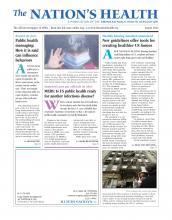Many deaths due to leading causes preventable
Up to 40 percent of U.S. deaths associated with the five leading causes of death are preventable, the Centers for Disease Control and Prevention reported in May.
In a study published in the agency's Morbidity and Mortality Weekly Report, researchers studied premature deaths from heart disease, cancer, chronic lower respiratory diseases, stroke and unintentional injuries in every state between 2008 and 2010. The study found that if all states met the lowest death rate documented for each of the five causes, between 20 percent and 40 percent of 900,000 annual deaths could be prevented. Specifically, 34 percent of premature deaths from heart diseases could be prevented, as could 21 percent of premature cancer deaths, 39 percent of premature deaths due to chronic lower respiratory diseases, 33 percent of premature stroke deaths and 39 percent of premature deaths due to unintentional injury.
The study noted that modifiable risk factors contribute to each of the leading causes of death, such as tobacco use, physical inactivity, poor diet, alcohol abuse and workplace hazards.
For a copy of the study, visit www.cdc.gov/mmwr.
Half of Americans taking prescriptions
Between 2007 and 2010, about half of all Americans reported taking one or more prescription drugs in the previous month, according to a new federal report.
Released in May by the National Center for Health Statistics at the Centers for Disease Control and Prevention, “Health, United States, 2013” includes a special section on prescription drug use. The report found that during the same time period, one in 10 Americans took five or more prescription drugs in the previous month. Cardiovascular drugs, such as those to treat high blood pressure and heart disease, as well as cholesterol drugs were the most common drugs used among adults and seniors. The use of cholesterol-lowering drugs among adults ages 18 years old to 64 years old increased more than six-fold since 1988-1994.
Other commonly used drugs among adults were pain relievers and antidepressants. The report also found that prescribing antibiotics for cold symptoms declined 39 percent, while deaths involving prescription pain relievers more than tripled in the past decade.
For a copy of the report, visit www.cdc.gov/nchs.
Turkey's tobacco tax tied to smoking decline
Smoking declined by nearly 15 percent in Turkey after implementation of a tobacco tax, according to a study published in May in Morbidity and Mortality Weekly Report.
Turkey's tobacco tax took effect in 2010, increasing the price of cigarettes by more than 42 percent. In addition to an overall decrease in smoking prevalence, the largest reductions were documented among people with a lower socioeconomic status, “highlighting the potential role of tax policy in reducing health disparities across socioeconomic groups.
“The increase in tobacco tax in Turkey was associated with a greater reduction in smoking among persons with the lowest wealth than among wealthier persons,” the study stated. “This suggests that the tax increase did not have a regressive outcome because smoking and its associated expense declined most among those who could least afford the habit.”
In addition to the tobacco tax, Turkey also banned smoking in public places, banned cigarette advertising and introduced graphic health warnings.
For more information, visit www.cdc.gov/mmwr.
Obesity in women linked to poor infant outcomes
Higher body mass index before or in early pregnancy is linked with an increased risk of fetal death, stillbirth and infant death, with women who are severely obese at greatest risk.
The findings, which were published in the April 16 issue of Journal of the American Medical Association, were based on a review of PubMed and Embase databases and included thousands of fetal deaths, stillbirths, perinatal deaths, neonatal deaths and infant deaths. Researchers found that even modest increases in body mass index were associated with a higher risk of fetal death, stillbirth, neonatal death, perinatal death and infant death. The greatest risk was found among severely obese women with a body mass index of 40, who had a two- to three-fold increase in poor infant survival outcomes.
Researchers noted that being overweight or obese increases the risk of gestational diabetes, Type 2 diabetes, gestational hypertension, congenital anomalies and preeclampsia, all of which can affect the health of a fetus and infant.
Health researchers shy away from social media
Only a small minority of health researchers are using social media, despite the opportunities it presents to reach the public and policymakers, a recent study finds.
Published in the July issue of Health Affairs, the study surveyed 325 health policy researchers attending the 2013 Academy Health Annual Research Meeting. The study found that only 14 percent of respondents used Twitter and only 21 percent blogged about their research in the previous year. Researchers described social media as being incompatible with research and reported that they were uncertain of its effectiveness and were unfamiliar with the technology.
For example, one survey respondent said “I would not use something that's so succinct that it could allow for misinterpretation,” while another researcher said that “anyone could write a 140-word Twitter statement that may or may not be true, and there's the risk…that you can just get confused with the junk that's out there.” Many participants also believed that researchers are critical of social media and feared they would make a mistake on social media that would land them in trouble.
Study authors called on universities, research funders and scientists to study how health researchers can best use and adapt to social media tools, noting that social media could help narrow the communication gap between researchers and policymakers.
- Copyright The Nation’s Health, American Public Health Association









